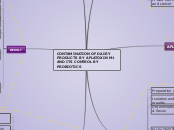CONTAMINATION OF DAIRY PRODUCTS BY AFLATOXIN M1 AND ITS CONTROL BY PROBIOTICS
AFLATOXIN
Highly toxic produced by the species of Aspergillus
A. flavus
A. parasiticus
It can grow under favourable temperature and humidity
Contamination occur from
field
harvest
handling
storage
It also can cause liver damage and cancer
AFLATOXIN M1
The hydroxylated matabolite of aflatoxin B1
Less carcinogenic and mutagenic than AFB1
Found when lactating animals are fed with contaminated feedstuff
Relatively stable during pasteurization and storage
Not destroyed
Possible accumulation and linkage to DNA
risk more to the infants
METHOD
Preparation of sample
Isolation and identification of moulds
Determination of toxigenic of A.flavus
ELISA TEST
AFM1 determination
Sample preparations
AFM1 evaluation
Statistical Analysis
Detoxification of AFM1 in Yoghurt by Lactic acid Bacteria
Cultures activation
Preparation of lactic acid bacteria inoculum
Binding ability of LAB in AFM1 contaminated milk
Probiotics use
reducing the availability of AFs
Example
Lactobacillus
Bifidobacterium
involves physical binding of the toxin to the bacterial cell wall
AFM1 bind to milk protein
Bifidobacterium lactis
more ability to remove AFM1
Play important role in digestive and respiratory
RESULT
1 out of 9 isolates of A.flavus produced aflatoxin
Mozarella cheese have the highest rate exceeding the permissible rate
Aflatoxin mostly found in raw milk samples
The results obtain depends on the country
Concentration of AFM1 in cheese depends on some variable
type of cheese
water content
production technologies
Concentration of AFM1 in yoghurt depends on some variable
manufacturing procedures
type of yogurt
condition of yoghurt ripening
country and season
CONCLUSION AND RECOMMENDATION
Milk and dairy product have to be controlled continuosly
Maintain low levels of AFB1 in the feeds of dairy animals
Widespread and continuous training for both the producers and consumers
Apply ideal recommend limit to minimize the AFM1 contamination in milk
